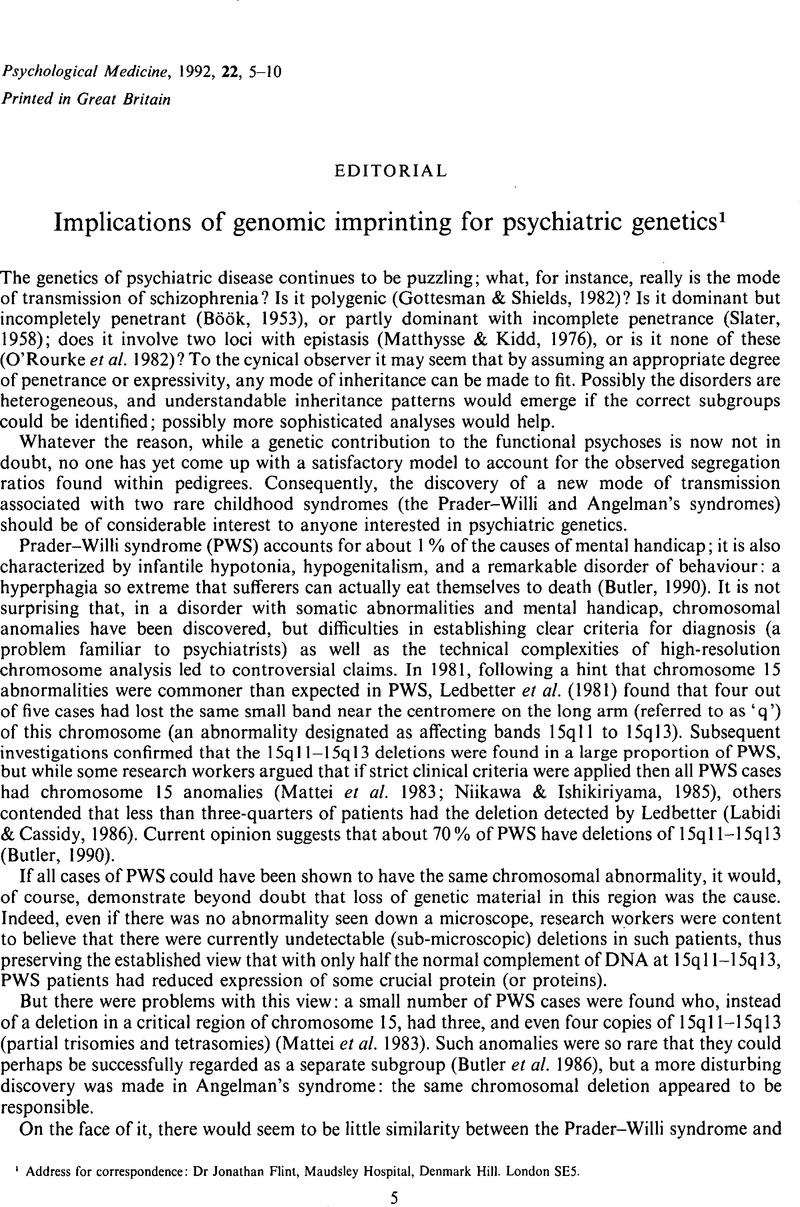Crossref Citations
This article has been cited by the following publications. This list is generated based on data provided by Crossref.
Solter, Davor
1992.
Relevance of genomic imprinting to human diseases.
Current Opinion in Biotechnology,
Vol. 3,
Issue. 6,
p.
632.
1993.
Can classic hypotheses be interpreted within a neurodevelopmental framework?.
The Lancet,
Vol. 341,
Issue. 8844,
p.
534.
Rutter, M.
1994.
Psychiatric genetics: Research challenges and pathways forward.
American Journal of Medical Genetics,
Vol. 54,
Issue. 3,
p.
185.
O'Donovan, Michael C.
and
Owen, Michael J.
1996.
Dynamic mutations and psychiatric genetics.
Psychological Medicine,
Vol. 26,
Issue. 1,
p.
1.
Kato, Tadafumi
Winokur, George
Coryell, William
Keller, Martin B.
Endicott, Jean
and
Rice, John
1996.
Parent-of-origin effect in transmission of bipolar disorder.
American Journal of Medical Genetics,
Vol. 67,
Issue. 6,
p.
546.
Bassett, Anne S.
Bury, Alison
Hodgkinson, Kathleen A.
and
Honer, William G.
1996.
Reproductive fitness in familial schizophrenia.
Schizophrenia Research,
Vol. 21,
Issue. 3,
p.
151.
Bolton, Patrick
1996.
Genetic Advances and Their Implications for Child Psychiatry.
Child and Adolescent Mental Health,
Vol. 1,
Issue. 3,
p.
82.
Husted, Janice
Scutt, Laura E.
and
Bassett, Anne S.
1998.
Paternal transmission and anticipation in schizophrenia.
American Journal of Medical Genetics,
Vol. 81,
Issue. 2,
p.
156.
Kato, Tadafumi
Winokur, George
Coryell, William
Rice, John
Endicott, Jean
Keller, Martin B.
and
Akiskal, Hagop S.
1998.
Failure to demonstrate parent-of-origin effect in transmission of bipolar II disorder.
Journal of Affective Disorders,
Vol. 50,
Issue. 2-3,
p.
135.
Kornberg, J.R
Brown, J.L
Sadovnick, A.D
Remick, R.A
Keck, P.E
McElroy, S.L
Rapaport, M.H
Thompson, P.M
Kaul, J.B
Vrabel, C.M
Schommer, S.C
Wilson, T
Pizzuco, D
Jameson, S
Schibuk, L
and
Kelsoe, J.R
2000.
Evaluating the parent-of-origin effect in bipolar affective disorder.
Journal of Affective Disorders,
Vol. 59,
Issue. 3,
p.
183.
Ewald, Henrik
2000.
Bipolar Disorders.
p.
243.
Goos, Lisa M
and
Silverman, Irwin
2001.
The influence of genomic imprinting on brain development and behavior.
Evolution and Human Behavior,
Vol. 22,
Issue. 6,
p.
385.
van Os, J.
Rutten, B. P.
and
Poulton, R.
2008.
Gene-Environment Interactions in Schizophrenia: Review of Epidemiological Findings and Future Directions.
Schizophrenia Bulletin,
Vol. 34,
Issue. 6,
p.
1066.
Goos, Lisa M.
and
Ragsdale, Gillian
2008.
Genomic Imprinting.
Vol. 626,
Issue. ,
p.
71.
van Os, Jim
and
Poulton, Richie
2009.
The Recognition and Management of Early Psychosis.
p.
47.
Rutten, B. P. F.
and
Mill, J.
2009.
Epigenetic Mediation of Environmental Influences in Major Psychotic Disorders.
Schizophrenia Bulletin,
Vol. 35,
Issue. 6,
p.
1045.
van Os, Jim
Rutten, Bart P.F.
and
Poulton, Richie
2010.
Advances in Schizophrenia Research 2009.
p.
19.
Smith, Rebecca
and
Mill, Jonathan
2011.
Epigenetic Aspects of Chronic Diseases.
p.
1.
Lester, Barry M.
Conradt, Elisabeth
and
Marsit, Carmen
2016.
Introduction to the Special Section on Epigenetics.
Child Development,
Vol. 87,
Issue. 1,
p.
29.
Holland, Anthony J.
Aman, Lucie C.S.
and
Whittington, Joyce E.
2019.
Defining Mental and Behavioural Disorders in Genetically Determined Neurodevelopmental Syndromes with Particular Reference to Prader-Willi Syndrome.
Genes,
Vol. 10,
Issue. 12,
p.
1025.



